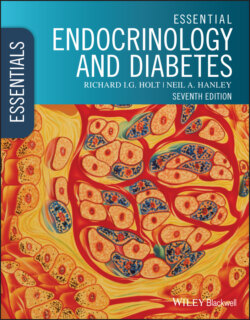Читать книгу Essential Endocrinology and Diabetes - Richard I. G. Holt - Страница 59
Box 3.2 Binding characteristics of hormone receptors
ОглавлениеHigh affinity: hormones circulate at relatively low concentrations – receptors are like ‘capture systems’
Reversible binding: one reason for the transient nature of endocrine responses
Specificity: receptors distinguish between closely related molecular structures
Protein phosphorylation is a key molecular switch. Approximately 10% of proteins are phosphorylated at any given time in a mammalian cell. The phosphate group is donated from ATP during catalysis by the kinase enzyme. It is accepted by the polar hydroxyl group of the amino acids, serine, threonine or tyrosine (Figure 3.5a) and causes a conformational change in the three‐dimensional shape of the protein (Figure 3.5b). In many signalling cascades, the phosphorylated protein can also act as a kinase and phosphorylate the next protein in the sequence. This relays and amplifies the intracellular signal generated by the hormone binding to its receptor (Figure 3.5c).
Figure 3.3 Hormone–receptor systems are saturable. Increasing amounts of labelled hormone are incubated with a constant amount of receptor. The amount of bound labelled hormone increases as more is added until the system is saturated. At this point, further addition of hormone fails to increase the amount bound to receptors. The concentration of hormone that is required for half‐maximal saturation of the receptors is equal to the dissociation constant (K D) of the hormone–receptor interaction.
Figure 3.4 Hormone–receptor interactions are reversible. Constant amounts of labelled hormone and receptors are incubated together for different times. The bound label increases with time until it reaches a plateau, when the bound and free hormone has reached a dynamic equilibrium. In a dynamic equilibrium, hormone continually associates and dissociates from its receptor. Adding excess unlabelled hormone competes for access to the receptors. Consequently, the amount of bound labelled hormone decreases with extended incubation (dashed line).
